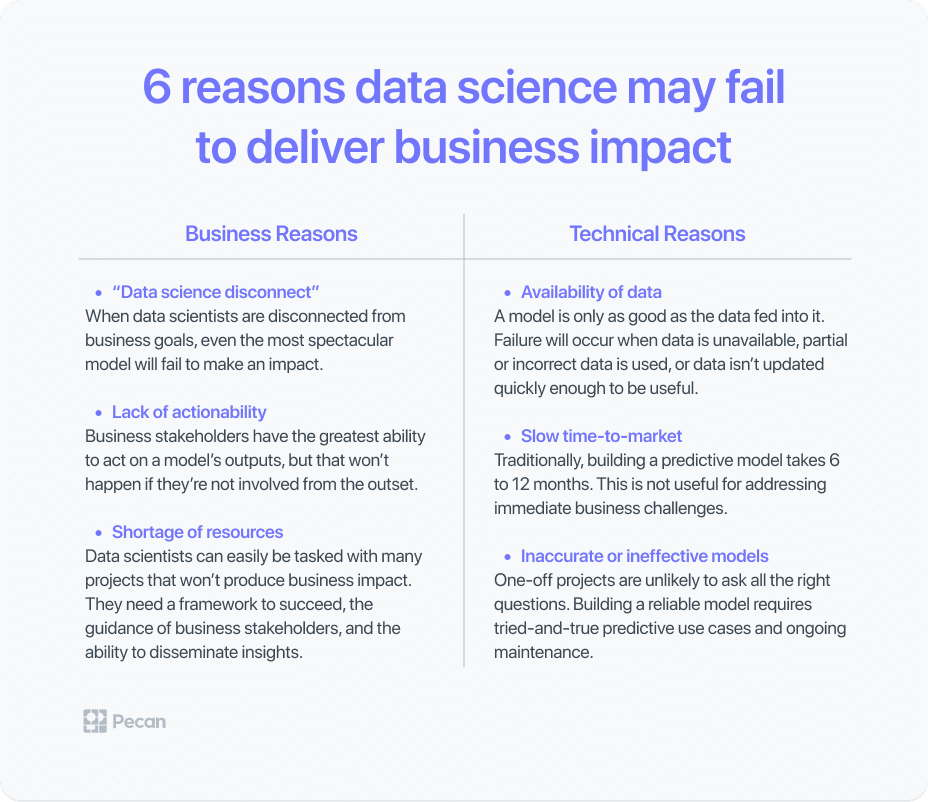In a nutshell:
- Many organizations are leveraging AI for business impact, but smaller organizations struggle to implement effective data science programs.
- Data scientists often fail to deliver business impact due to a disconnect from business goals and processes.
- Data analysts are best-equipped to pursue predictive analytics and can easily contribute to reducing churn or predicting customer lifetime value.
- Embedding data analysts within business teams improves understanding of business needs, response time, collaboration, and impact.
- With modern predictive analytics platforms, data analysts can leverage AI and build predictive models using their existing skill set.
We’ve long said that forward-thinking organizations understand that AI will power the next business revolution.
But frankly, that’s no longer true.
Why? Because now every organization knows it.
From Amazon to Google, Apple to Tesla, and Spotify to OpenAI, nearly every successful tech company is leveraging AI to create massive business impact. This is the case whether they’re providing customers with recommendations, predicting product demand, or powering the very nature of their offering.
The challenge for smaller organizations, though, is that there’s no one-size-fits-all approach for implementing effective and scalable data science programs that create real business impact.
As a result, most data science and AI projects fail – sometimes quietly, sometimes spectacularly, and often expensively. Oft-cited examples include Google’s translator headphones, Microsoft’s AI Twitter bot, Amazon’s AI for HR, and IBM’s Watson for Oncology.
Though written a few years back, this Gartner quote still rings true:
… 80% of AI projects will remain alchemy, run by wizards whose talents will not scale in the organization.
Gartner Research
If your organization is planning to invest in data science and AI projects with the hope of generating additional revenue, optimizing business processes or reducing costs, you must prepare for this future by understanding the mistakes of the past.
In this article, we’ll review:
- Why data scientists are often limited in their ability to drive business impact,
- Why data analysts with the right tools are best-positioned to carry out many AI initiatives, and
- And how your organization can empower them to do so.
Why data scientists often fail to deliver business impact
There are several reasons why data scientists, no matter how skilled or talented they are, may fail to produce strategic business outcomes. And most of those reasons are structural in nature.
The most salient reason is what we call “the data science disconnect.” This refers to their lack of connection to business KPIs and processes, particularly because of the way they are integrated into organizations.
In Anaconda Research’s 2020 State of Data Science report, they asked hundreds of data scientists, analysts and analytics executives how data science initiatives are structured at their organizations.
The result? A number of very different approaches, as shown below.
Where data scientists typically work in organizations
In that survey, 28% of data-scientist respondents belong to a Data Science Center of Excellence, while 22% belong to R&D teams. In both cases, they belong to a department that is typically far-removed from business teams, aren’t familiar with the day-to-day concerns and activities of other departments, and don’t dig into the nuances of other teams’ data.
This lays the groundwork for a mismatch in goals from the moment a project begins. A data scientist may find value in building, say, a model related to computer vision, whereas building a model that predicts churn might be more in line with immediate business needs.
While one model would be unhelpful for most business teams, the other model could directly address the company’s #1 pain point – and be a terrific opportunity for data scientists to showcase their ability to use AI in the service of business KPIs.
However, when data scientists are relegated to their own siloed center of excellence, there is a fundamental disconnect. In most organizations, they still have a long way to go in terms of contributing to the company’s bottom line and achieving meaningful impact.
The reasons data science may fail to deliver business impact are complex and can be difficult to resolve.
The above reasons are consistent with our 2022 State of Predictive Analytics in Marketing report, where survey respondents reported that data projects stall when collaborations between marketing and data scientists are misaligned. These tend to be the three primary factors:
- Failing to establish a shared understanding of business needs and available data
- Reliance on data scientists’ availability and turnaround time
- Inability to maintain models and data in production
Why data analysts are best-equipped to pursue predictive analytics
Most companies cannot afford to create a data science Center of Excellence that indirectly serves the rest of their company. What they need is data specialists who can understand and focus on specific needs of the business.
They need people who are able to connect the data, are able to deploy and manage models, and are close to the business stakeholders – who are then able to take action.
By working in tandem with their business teams to solve business problems, data analysts are best-positioned to acquire and share these AI-powered insights. This approach is illustrated below:
Business stakeholders and data analysts can collaborate successfully to make significant business impact.
Today, the reality is that most data analysts already possess the skills and knowledge required to build predictive models. So with the right tool in hand, once they’re aligned with your business needs, an analyst can easily contribute to reducing customer churn or predicting customer lifetime value – things that will have a massive impact on your business.
Five years ago, the story would have been different: predictive analytics required one to have coding skills, advanced analytics skills, a deep understanding of data science, and more.
But the list today is less daunting, as innovative technologies now put the power of AI into the hands of almost any data specialist. And as solutions like Pecan continue to evolve, they are only becoming more and more accessible – not just for data analysts, but also for everyday business professionals.
The skills needed today for predictive analytics
Sure, if you’re building a computer-vision or natural language processing model, a data scientist will be better equipped to lead the charge. But for most types of predictive analytics, a data analyst can easily learn the basics of predictive analytics and start making real contributions to the business’s bottom line.
For a quick review of what those specific skills are, check out our 3-minute guide, “Skills for Predictive Analytics.”
How to position data analysts to succeed
There’s a clear way to extract more value from data analysts who are tasked with carrying out predictive analytics.
Rather than positioning them on an independent team or relying on external consultants, your organization should embed data analysts within existing business teams. This has several clear benefits:
- Better understanding of business needs: They’ll be better positioned to identify key metrics that the business team cares about, and can then build models to address those needs.
- Faster response time: They can quickly respond to requests for analysis or insights, and then provide the team with real-time feedback that can help inform decision-making.
- Improved collaboration: They can work more closely with the business team to identify key questions and hypotheses, and the team can provide greater context for the data being analyzed.
- Greater impact: They’ll be able to provide more targeted insights and recommendations specific to the team’s needs, which can help drive better decision-making regarding actions, and improve outcomes.
In summary, integrating a data analyst within a business team will help them understand many of the things that an external analyst – or a data scientist – typically will not.
When you combine that with an understanding of data sources and structure, model variables, potential issues of bias and the limitations of available data, they’ll be able to make informed recommendations about how to build models. The team as a whole will be far better prepared to take meaningful action based on the resulting predictions.
Wrapping up
Predictive analytics has immense potential to help your team achieve your most significant metrics for success. And it no longer requires the super-advanced skills that have always been the domain of data scientists.
With the innovation, ease and affordability of modern predictive analytics platforms, data analysts can now leverage AI and build predictive models using their existing skill set.
And by embedding data analysts within business teams, you can break down company silos, foster better collaboration, and empower them to deliver more impactful insights – so you can generate better business outcomes.
Ready to give it a try now? Start a free trial and see how easy it can be to predict the future, whether you're a data scientist or data analyst.







